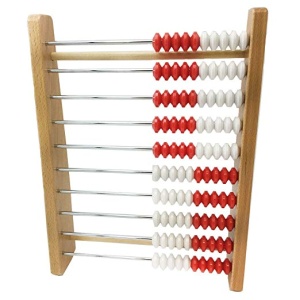Do you need to use manipulatives with Math Mammoth?
For the most part, Math Mammoth curriculum does not specifically emphasize manipulatives, but it uses visual models a lot. The exercises that use visual models can be done with manipulatives instead (counters, base ten blocks, fraction manipulatives, etc.), if you prefer.
The exception is the 100-bead abacus, which is used in first grade in teaching place value and numbers up to 100.
On each of these pages you will see a list of needed manipulatives and tools for grades 1-3. Most of them are measurement tools.
I might also mention... there is no need to go overboard with manipulatives.
This video gives an eye-opening illustration of how excessive manipulative use can lead to problems.
The girl solves a 4-digit addition problem by drawing thousand-blocks, hundred-sheets, ten-sticks and one-dots on the board, taking 8 minutes (and getting the wrong answer)! Then she says that at home she has been taught to stack the numbers and add. She solves it that way, too, taking 1 minute (getting the correct answer). And she clearly understands that the stacking method (adding in columns) is way easier and more organized.
Here's a tidbit from an actual study. Quoting from an article at Education Week (Studies Find That Use of Learning Toys Can Backfire):
In a similar series of experiments at the elementary-school level, the researchers found that children taught to do two-digit subtraction by the traditional written method performed just as well as children who used a commercially available set of manipulatives made up of individual blocks that could be interlocked to form units of 10.
Later on, though, the children who used the toys had trouble transferring their knowledge to paper-and-pencil representations. Mr. Uttal and his colleagues also found that the hands-on lessons took three times as long as the traditional teaching methods did.
Manipulatives are GOOD, used in their rightful place. They are a good starting point, and they help students to understand concepts, initially, on a concrete level. But children should not be taught to rely on them. They need to transfer the concrete play into the abstract afterwards and to learn to make generalizations. That is where the power of mathematics is.
Let's say, for example, that you use base ten blocks to illustrate the concept of regrouping in addition. Once the student understands that, they should be able to translate their knowledge into paper-and-pencil work, and to bigger and smaller place values (including decimal addition).
Math Mammoth books often instruct concepts with pictures, which essentially take the place of manipulatives. Then the student does exercises that use the same pictorial representation, including having to draw those same visual models to illustrate the problems. After that, the student goes on to the totally abstract representation.
Here's an example page from the book Math Mammoth Add & Subtract 2-B. The student first adds using the pictorial model, and then with numbers only.
So, it is the age-old truth: there is balance in everything.
By Maria Miller
Receive my monthly collection of math tips & resources directly in your inbox — and get a FREE Math Mammoth book!
You can unsubscribe at any time.
Math Mammoth TourConfused about the different options? Take a virtual email tour around Math Mammoth! You'll receive: An initial email to download your GIFT of over 400 free worksheets and sample pages from my books. Six other "TOURSTOP" emails that explain the important things and commonly asked questions concerning Math Mammoth curriculum. (Find out the differences between all these different-colored series!)This way, you'll have time to digest the information over one or two weeks, plus an opportunity to ask me personally about the curriculum. A monthly collection of math teaching tips & Math Mammoth updates (unsubscribe any time) We respect your email privacy.
Note: You will FIRST get an email that asks you to confirm your email address. If you cannot find this confirmation email, please check your SPAM/JUNK folder. |
"Mini" Math Teaching CourseThis is a little "virtual" 2-week course, where you will receive emails on important topics on teaching math, including:
- How to help a student who is behind You will also receive: A GIFT of over 400 free worksheets and sample pages from my books right in the very beginning.We respect your email privacy.
Note: You will FIRST get an email that asks you to confirm your email address. If you cannot find this confirmation email, please check your SPAM/JUNK folder. |
Maria's Math TipsEnter your email to receive math teaching tips, resources, Math Mammoth news & sales, humor, and more! I tend to send out these tips about once monthly, near the beginning of the month, but occasionally you may hear from me twice per month (and sometimes less often). Peek at the previous tips here. You will also receive:
We respect your email privacy.
|
|


